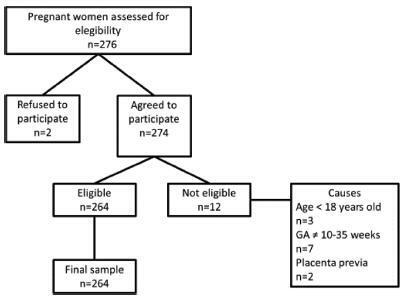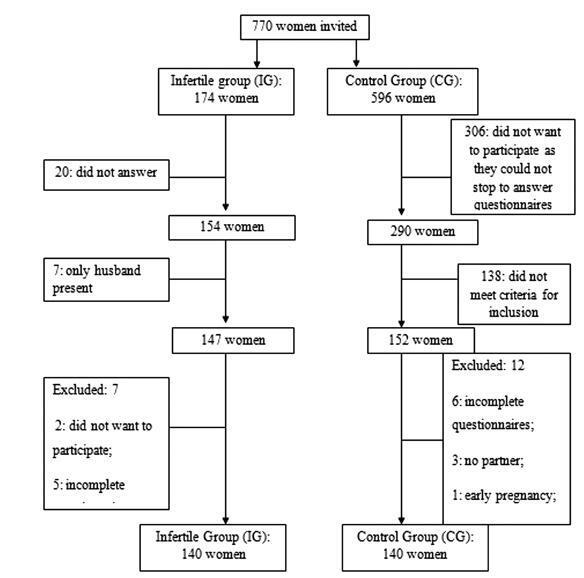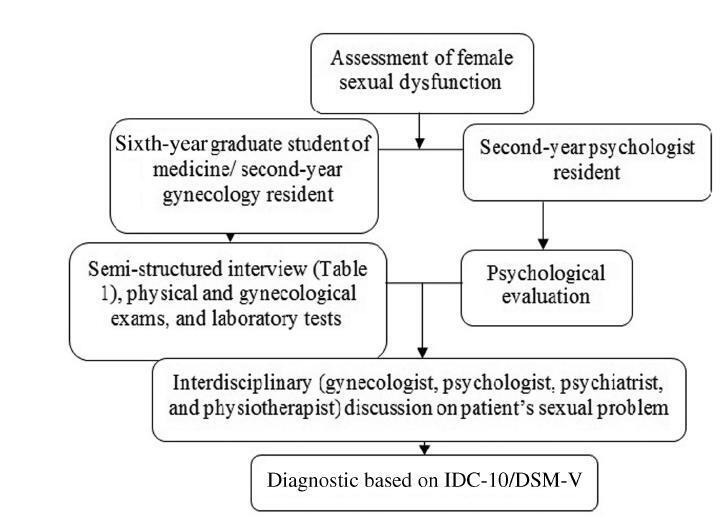-
Original Article09-30-2019
Prevalence of Sexual Dysfunctions and their Associated Factors in Pregnant Women in an Outpatient Prenatal Care Clinic
Revista Brasileira de Ginecologia e Obstetrícia. 2019;41(9):555-563
Abstract
Original ArticlePrevalence of Sexual Dysfunctions and their Associated Factors in Pregnant Women in an Outpatient Prenatal Care Clinic
Revista Brasileira de Ginecologia e Obstetrícia. 2019;41(9):555-563
Views241See moreAbstract
Objective
To determine the prevalence of sexual dysfunction and its associated factors in pregnant women.
Methods
A descriptive, cross-sectional study including 262 pregnant women aged 18 years or older with gestational age between 10 and 35 weeks. Women with urinary tract infections and conditions of gestational risk were excluded. The Pregnancy Sexual Response Inventory (PSRI) questionnaire was used. We performed a univariate descriptive analysis, and comparisons between the mean values of the sexual function domains were made using the Student t-test. The chi-squared test was used to determine the association between the independent and dependent variables. The prevalence ratios, with their respective 95% confidence intervals, were also estimated, and a multivariate analysis was performed.
Results
A total of 64.9% of women reported a decrease in the frequency of sexual activity during pregnancy. Slightly more than half of the women (50.8%) were satisfied, and arousal was reported as excellent/good by 30.5% of them. The frequency of sexual difficulties/dysfunctions increased with pregnancy, rising from 5.7% to 58.8%, and pain during sexual intercourse was reported by 45.8% of them. Having higher education degree decreased the chance of being sexually dissatisfied by 50%. The total PSRI score showed a significant decrease from the prepregnancy period (mean score = 89.8, “excellent”) to the pregnancy period (mean score = 59.2, “good”).
Conclusion
The mean sexual function score during pregnancy was classified as good, although most pregnant women reported at least one type of alteration in the sexual function domains, and the report of dissatisfaction was more frequent in women with lower schooling.

-
Original Article06-19-2019
Sexual Function and Quality of Life in a Cohort of Brazilian Users of Two Kind of Intrauterine Contraceptives
Revista Brasileira de Ginecologia e Obstetrícia. 2019;41(4):236-241
Abstract
Original ArticleSexual Function and Quality of Life in a Cohort of Brazilian Users of Two Kind of Intrauterine Contraceptives
Revista Brasileira de Ginecologia e Obstetrícia. 2019;41(4):236-241
Views217See moreAbstract
Objective
To compare sexual function and quality of life (QOL) among intrauterine contraceptive (copper-intrauterine device [Cu-IUD] or the 52-mg 20 μg/day levonorgestrel- releasing intrauterine system [LNG-IUS]) users.
Methods
This was part of a cross-sectional study. Women aged between 18 and 49 years old, in a heterosexual relationship, reporting sexual intercourse in the previous 4 weeks, using Cu-IUD (Group 1) or LNG-IUS (Group 2) responded to a questionnaire with sociodemographic information, to the Female Sexual Function Index (FSFI), to the World Health Organization QOL Questionnaire Abbreviated Version (WHOQOL-BREF), and to a questionnaire about the contraceptive method used. The Student t-test, the Pearson χ2 test or the Fisher exact test, and the Mann-Whitney test were used for the analysis. For the adjusted comparison, we have used the analysis of covariance (ANCOVA). A multiple regression analyzing factors related to FSFI 26.55 was done. Significance was established at p < 0.05.
Results
A total of 347 women in Group 1 (mean age of 32.3 ± 7.5 years old) and of 298 in Group 2 (mean age of 32.7 ± 6.4 years old) completed the questionnaires.Most women had ≥ 8 years of schooling, were in amonogamous relationship, and had had ≤ 2 pregnancies. A total of 122 Cu-IUD and of 87 LNG-IUS users scored ≤ 26.55 on the FSFI. Significant lower scores in physical, environmental, and overall QOL domains in the WHOQOL-BREF questionnaire were found in Group 1. More women using the Cu- IUD were not satisfied with the method.
Conclusion
We did not find significant differences in sexual function; there was a lower score in some domains of QOL among women who used the Cu-IUD. It was not possible to ensure that those differences were related to the contraceptive method.
-
Original Article12-01-2018
Sexual Function of Women with Infertility
Revista Brasileira de Ginecologia e Obstetrícia. 2018;40(12):771-778
Abstract
Original ArticleSexual Function of Women with Infertility
Revista Brasileira de Ginecologia e Obstetrícia. 2018;40(12):771-778
Views196Abstract
Objective
To assess the sexual function, anxiety, and depression of infertile women relative to a control group.
Methods
Infertile women (infertile group, IG) of reproductive age were invited to participate in this controlled study. A control group (CG) of women was recruited from the general population of the same city. Sexual function was assessed by the Female Sexual Function Index (FSFI), and anxiety and depression were measured by the Hospital Anxiety and Depression Scale (HADS).
Results
A total of 280 women participated in the present study, 140 in the IG and 140 in the CG. The analysis of the FSFI scores showed that 47 women (33.57%) in the IG and 49 women (35%) in the CG had sexual dysfunction (FSFI ≤ 26.55; p = 0.90). Women with anxiety or depression had a greater risk of sexual dysfunction, and sexual dysfunction increased the risk of anxiety and depression. Married women had a lower risk of depression than single women who were living with their partners.
Conclusion
Infertilewomenhadno increased riskof sexual dysfunction relativetocontrols. Anxiety and depression increased the risk of sexual dysfunction in the studied population.
Key-words AnxietyAssisted reproductionDepressionfemale sexual dysfunctionmarital infertilitySexualitySee more
-
Original Article06-01-2018
Score Establishment and Brazilian Portuguese version of the Pregnancy Sexual Response Inventory (PSRI)
Revista Brasileira de Ginecologia e Obstetrícia. 2018;40(6):322-331
Abstract
Original ArticleScore Establishment and Brazilian Portuguese version of the Pregnancy Sexual Response Inventory (PSRI)
Revista Brasileira de Ginecologia e Obstetrícia. 2018;40(6):322-331
Views197See moreAbstract
Objective
To establish the Pregnancy Sexual Response Inventory (PSRI) scores for each domain before and during pregnancy, and to publish the Brazilian Portuguese version of the PSRI.
Methods
Pregnant women were recruited during antenatal care; the PSRI was administered to 244 women prenatally at Faculdade de Medicina de Botucatu, at Universidade do Estado de São Paulo (UNESP, in the Portuguese acronym). The PSRI scores were estimated based on the Kings Health Questionnaire (KHQ) and the Medical Outcomes Study 36-item short form survey (SF-36). The raw scale type was used to standardize the minimal value and amplitude of each domain. For each domain, the score varied from 0 to 100, and the composite score was obtained as the domain average. The composite score before and during pregnancy was determined by the sum of the scores of all specific domains for each divided by the full domain number. The categorization of the scale into quartiles was established when all PSRI-specific and composite scores were combined.
Results
The composite and specific scores for each domain were categorized into quartiles: 0 < 25 as “very bad;” 25 < 50 as “bad;” 50 < 75 as “good” and 75 to 100 as “excellent.” The mean scores were lower during pregnancy than before pregnancy in 8 of the 10 domains. The Brazilian Portuguese PSRI version is presented.
Conclusion
This study allowed the establishment of the PSRI composite and specific scores for each domain, and the categorization of scores into quartiles: very bad, bad, good and excellent. In addition, the Brazilian Portuguese version of the PSRI is presented in full for application in the Brazilian population.
-
Original Article09-01-2017
The Preference of Women and Men Regarding Female Genital Depilation
Revista Brasileira de Ginecologia e Obstetrícia. 2017;39(9):488-495
Abstract
Original ArticleThe Preference of Women and Men Regarding Female Genital Depilation
Revista Brasileira de Ginecologia e Obstetrícia. 2017;39(9):488-495
Views308See moreAbstract
Purpose
To evaluate the preferences of women and men regarding female pubic hair depilation and identify possible reasons for these preferences.
Methods
This is a cross-sectional study of men and women over 18 years old who were invited by the official blog of our institution to respond anonymously to an online and self-administered questionnairemade by the researchers. The analyses weremade using the Statistical Analysis System (SAS, SAS Inc., Cary, NC, US) software, version 9.3, and contingency tables were used to verify the distribution of variables. The univariate statistical analysis was performed using the Pearson chi-squared test, and the differences for values of p < 0.05 were considered significant.
Results
We obtained data from 69,920 subjects (52,787 women and 17,133 men). Themean age was 31.9 years formen, and 28.5 years for women. Most women (64.3%) and men (62.2%) preferred complete removal of female pubic hair, and this preference wasmore pronounced in younger women andmen. Most women reported performing depilation at home (55.8%), with 44.4% using hot wax and 40.1% using a razor blade. About half of the women (44.7%) and men (50.1%) reported sexual activity, having intercourse 2 to 3 times per week. The frequency of intercourse and sexual satisfaction in women correlated with total pubic hair removal.
Conclusion
Most Brazilian women and men prefer the complete removal of female pubic hair, especially those who are younger andmore sexually active.Women who are satisfied with the appearance of their own genitalia have a stronger preference for complete removal of pubic hair.
-
Original Article04-01-2017
A Model for the Management of Female Sexual Dysfunctions
Revista Brasileira de Ginecologia e Obstetrícia. 2017;39(4):184-194
Abstract
Original ArticleA Model for the Management of Female Sexual Dysfunctions
Revista Brasileira de Ginecologia e Obstetrícia. 2017;39(4):184-194
Views230See moreAbstract
Introduction
Sexual pleasure is fundamental for the maintenance of health and well-being, but it may be adversely affected by medical and psychosocial conditions. Many patients only feel that their health is fully restored after they resume normal sexual activities. Any discussion of sexuality in a doctor's office is typically limited, mainly because of a lack of models or protocols available to guide the discussion of the topic.
Objectives
To present a model designed to guide gynecologists in the management of female sexual complaints.
Methods
This study presents a protocol used to assess women's sexual problems. A semi-structured interview is used to assess sexual function, and the teaching, orienting and permitting (TOP) intervention model that was designed to guide gynecologists in the management of sexual complaints.
Results
The use of protocols may facilitate the discussion of sexual issues in gynecological settings, and has the potential to provide an effective approach to the complex aspects of sexual dysfunction in women. The TOP model has three phases: teaching the sexual response, in which the gynecologist explains the physiology of the female sexual response, and focuses on the three main phases thereof (desire, excitement and orgasm); orienting a woman toward sexual health, in which sexual education is used to provide information on the concept and healthy experience of sexuality; and permitting and stimulating sexual pleasure, which is based on the assumption that sexual pleasure is an individual right and is important for the physical and emotional well-being.
Conclusion
The use of protocols may provide an effective approach to deal with female sexual dysfunction in gynecological offices.

-
Original Article11-01-2016
Prevalence of Sexual Dysfunction among Expectant Women
Revista Brasileira de Ginecologia e Obstetrícia. 2016;38(11):559-563
Abstract
Original ArticlePrevalence of Sexual Dysfunction among Expectant Women
Revista Brasileira de Ginecologia e Obstetrícia. 2016;38(11):559-563
Views190See moreAbstract
Purpose
To identify pregnancy as a causative factor of sexual dysfunction among expectant women.
Methods
A prospective study with 225 expectant mothers seen in the prenatal clinic of a federal university. Sexual function was evaluated by means of the Female Sexual Function Index (FSFI), and all domains were analyzed (desire, arousal, lubrication, orgasm, satisfaction, and pain). Initially, a univariate analysis of the sample was done. The averages for each domain according to the risk of sexual dysfunction (FSFI ≤ 26.5) were compared using the Student’s t-test for independent samples. The strength of the correlation between sexual dysfunction and all sociodemographic, clinical and behavioral variables was measured by the Chi-Square (X2) test. Then, odds ratios (ORs) and their confidence intervals were assigned to perform a bivariate analysis. Any p values less than 0.05 were considered significant.
Results
Approximately two-thirds of the women (66.7%) showed signs of risk of sexual dysfunction (FSFI ≤ 26.5). Within these cases, all sexual dysfunction domains (desire, arousal, lubrication, orgasm, satisfaction, and pain) were found to be statistically significant (p < 0.001). The domains most affected were desire (2.67), satisfaction (2.71) and arousal (2.78).
Conclusions
Pregnancy appears to be an important causative factor of sexual dysfunction among pregnant women.


